What singers of Early Music can learn from listening to vocal jazz
Leila Heil
- 1. Introduction
- 2. Vocal tone and vibrato
- 3. Structural similarities in Early Music styles and Jazz
- 4. Importance of the text
- 5. Visual spectrogram examples
- 6. Conclusion
- Bibliography
- Discography
- Biographical note
1. Introduction
The exploration and study of history as a means of informing our present is common practice in most areas of inquiry including musicology and music performance. By finding the structures and contexts in which musics were originally written and performed, we can confidently reproduce these musics with some measure of authenticity. It is equally compelling, however, and less frequently attempted to think about how our understanding of past practice could be deepened by what we know in the present. While musical genres exist in various environmental contexts and specific musical style considerations vary between time periods, it may well be that the way in which we approach artistic decisions and use our artistic instincts have not changed over time as much as we may think. We may possibly gain valuable insights into performance practice of a past genre by studying aspects of artistic choice in a closely related modern genre. In this paper, I will explore this phenomenon by investigating the question ‘what could singers of early music learn from a related modern art form such as jazz?’Similarities between jazz and early music are certainly not a new source for speculation but the question of how modern jazz practice can inform current early music practice challenges the natural progression of historical scholarship. To negotiate and justify this turn of chronological inquiry, it is logical to look at the modalities of jazz learning that are applicable to early music study. For the jazz musician, the most valuable learning resource is listening. Whether to live music or recordings, jazz musicians view listening as a means of learning jazz style and enhancing artistry. The practice of learning through listening also seems to have been valued by early musicians. In the 16th century, for example, Ludovico Zacconi suggested that listening to diminutions or improvisations by ear was far more effective than seeing them in written form.1
While listening as an instructional tool is common in all forms of music today, I would argue that listening in the jazz genre is different from the type of listening commonly used in more classical styles. For Western classical forms of music, accepted performance practice requires a formal reproduction of the intent of the composer. Therefore, listening to interpretations of other artists exists as an ancillary mode for assimilating information. Jazz performance practice, by contrast, is based on the ability of an individual performer to create something unique from existing musical material by learning the language of the art form and applying it creatively. Given the stylistic features of much early music, which often seem to provide more of a template for performance than an exact formula, we might surmise that performers of early music, like jazz performers, were allowed a certain measure of artistic license when working within the general structures of the genre. Listening, then, may well serve as important a function for the performer of early music as it does for the jazz performer.
A primary resource available to jazz singers that is not available to singers of early music is a rich historical account of original audio recordings that details the development of vocal jazz singing from the earliest performances through today. Students of jazz can easily access early recordings of such jazz legends as Louis Armstrong and Ella Fitzgerald and compare these to recordings of hundreds of artists who have modified and developed the art form since. These audio recordings not only allow jazz singers to study and analyze the elements of jazz singing style but also to identify aspects of artistic choice. In his book, Embellishing Sixteenth-Century Music, Howard Brown suggests that the closest thing to authentic audio recordings for singers of early music are extant volumes of published music containing ornaments by 16th century performers such as Francesco of Milan, Pietro Paulo Borrono, and Alberto da Ripa.2 To this list we could add later compositions that included written out ornaments by Giulio Caccini and Claudio Monteverdi. While these sources provide specific evidence of the stylistic application of one element of early music performance, that being ornamentation, questions about other musical elements such as phrasing, voice quality, tempo choice, pronunciation factors and generalizability are left largely unspecified.
In this paper,
we will explore possibilities of using jazz recordings to inform an approach to
early Western art music. By understanding similarities in these two genres,
singers of early music can extract appropriate elements of jazz singing and
performance techniques for study. For our purpose, the term ‘early music’ will
encompass a period of time spanning the 14th–16th
centuries. While many specific genres and idioms exist within this general
framework, common compositional and performance elements will be discussed. Similarly,
the term ‘jazz’ will be used to include all jazz styles from the early 20th
century to the present. Again, while sub-categories of jazz music are distinct
in their stylistic traits, they share an overall ‘aesthetic,’ common musical
structures and general features of performance practice.
The
similarities between musics under the general umbrella of early Western art
music and jazz music are quite remarkable. Structural elements such as
ornamentation and improvisation along with the approach to text expression
(including pronunciation), and possibly even similarities in vocal tone and
singing technique are three areas of commonality that can be identified through
historical records and modern practice. I would first like to discuss possibly
the most controversial of these elements: vocal technique.
2. Vocal tone and vibrato
Maurio Umberti and Mark Lindley suggest that a shift in vocal technique occurred in the Romantic era resulting in two very different styles of singing, which they term early and modern. Early vocal technique favoured suppleness and agility,3 while the modern technique favours power, fosters a wide vibrato and has tremendous potential for projection. This modern technique, which came about as a result of the development of 19th century opera style and increased orchestra and theater size, has been widely accepted as the standard in the classical Western singing tradition for over 100 years.4
By contrast, the key factors in singing early music, as listed by George Newton, are the controlled use of vibrato, forward placement of sound, colouring of the vowels and keeping the larynx in a median rather than a low position.5 Michael Moubray-Silver suggests that early music demands variety in vocal tone colours. He reports that the voice was most often likened to the cornetto in early sources, which may indicate a bright vocal tone and further suggests that the voice may have been richer and reedier during that time period.6 It seems appropriate, based on this combined evidence, for singers of early music to consider a varied palette of vocal techniques from which they can select a range of vocal colours that may include bright singing and perhaps even consider the stylistic use of vibrato.
At the risk of oversimplifying the most appropriate use of the voice in early music, attention must be paid to apparent variations in singing tone during that time period. Giovanni Maffei (1562), for example, differentiated between a small and a big voice. A small voice was described as a cultivated voice, which was controlled and flexible with a big range and a ‘pliant throat given by nature.’ Maffei also suggested that singers use the voice with which they had been gifted.7 From this statement we might assume that a singer with a light and flexible instrument would sing music that highlighted the agility of the voice while a singer with a less flexible instrument might sing music that highlighted the ability to sing a legato phrase. One might take Maffei’s idea one step further and infer that singers should use the voice with which they had been gifted in the most appropriate manner for a particular style. Singers who specialize in jazz generally make musical choices that align well with their natural singing ability, as is evidenced in jazz recordings. Singing technique and vocal tone varies greatly between singers, even in different recordings of the same songs, and includes all voice types. The famous jazz singer Johnny Hartman, for example, was gifted with a rich, sonorous voice perfect for the expression of melody with warmth and colour. Hartmann, however, did not make use of extensive florid improvisation. Ella Fitzgerald, on the other hand, was gifted with a naturally light and bright voice that was perfect for the virtuosic embellishments for which she became famous.
In addition to variations in voice types as suggested by Maffei, much evidence exists to suggest that differences in the size and acoustical properties of early venues impacted the techniques required of singers. Distinctions are made among singing in church (chiesa), in theater (teatro) and in chambers (camere).8 In his Instiutione Harmoniche (Venice, 1558), Gioseffo Zarlino states ‘in churches (cappelle) one sings in one manner, and in private (camera) in another: for there in cappella one sings in full voice and in camera one sings with a more submissive and suave voice, and without yelling.’ 9 The camera style of singing seems to be well aligned with traditional jazz singing technique, which was originally developed in small and intimate venues and took on the character of conversational interaction. A sparse form of keyboard accompaniment provided the jazz singer an appropriate acoustical background similar to smaller and dynamically softer accompanying instruments used in performances of early music such as the lute.
Today, the microphone serves as a tool that allows the jazz singer to maintain the authentic conversational chamber style of vocal production regardless of venue size or increased instrumental forces such as a big band or full jazz combo of bass, keyboard and drums. Jazz singers do not work for a natural projection of the sound, as is the focus of the Western Classical technique, but rather focus on vocal techniques that serve the interpretation of the music – such as agility, clarity of text, variation in vocal colour, stylizing and artistic use of vibrato. The nature of vocal jazz recordings allows a listener to clearly hear subtleties in the vocal techniques used by a given performer. The use of breath, vibrato choice, phrasing techniques and articulations are represented in the most pristine fashion, allowing for in-depth study of the manner in which each is applied.
A final consideration in the approach to vocal tone both in early music and jazz is the blurring of clear idiomatic distinctions between the voice and instruments. While the voice is valued in both genres for its inherent expressive qualities, sources provide specific performance techniques intended for both voices and instruments. The Giovanni Bassano ornamentation treatises of 1585 and 1591, for example, clearly state that the information contained within is intended for both singers and instrumentalists. Howard Mayer Brown points out that many other authors of early ornamentation practice also indicate that ‘instrumentalists used exactly the same techniques to embellish compositions as singers did.’ 10 For the jazz singer, the practice of shifting between expressive, lyric singing and negotiating technically challenging improvisations is common practice. Recordings are of great value in helping singers gain a sense of the ways in which different vocal artists, gifted with various vocal attributes, handle and balance this shift.
3. Structural similarities in Early Music styles and Jazz
The second major area of commonality between jazz and early music singing can be found in the embellishment of melodic structural elements. Embellishment in both genres is handled in two ways: either through ornamenting single notes and passages or by creating melodies through improvisation. In both genres, there is evidence of improvisation used as a purely extemporaneous creation of melody over a given harmonic foundation or as a means of obscuring the existing melody of a repeated song form. Rapid and sequential movement, along with agility are all listed as elements of improvisatory technique in both jazz and early music. Further, improvisation in both genres is expected to adhere to the harmonic structure of the original composition and maintain a steady tempo. 11
Both jazz and early music include a wide array of melodic ornaments. While a comparison of the specific ornaments used differs between genres, and is beyond the scope of this paper, I would argue that the technical vocal challenges posed in each are remarkably similar. Examples found in treatises that focus on sixteenth-century vocal ornamentation – such as those by Giovanni Camillo Maffei (1562), Giovanni Luca Conforto (1593), and Giovanni Battista Bovicelli (1594) along with discussions of ornamentation practice by Adrianus Petit Coclico (1552), Harmann Fink (1556) and Lodovico Zacconi (1593)12 indicate elements very similar to jazz such as rapid progressions of stepwise and intervallic movement, sequential patterns, and attention to cadential formulas. Differences between jazz and early music occur in stylistic performance practice with regard to syncopation, accidentals and an expanded harmonic jazz language, but melodic and rhythmic material bear remarkable similarities.
Listening examples can be invaluable to the singer who wishes to engage in improvisatory practice. Questions such as ‘how much ornamentation is too little or too much; which ornaments should be used where; and should the use of ornaments depend solely on singer ability and skill?’ can be investigated through evaluating a final product. In the 16th century, Hermann Fink suggested that the practice of ornamentation should be dependent on the agility, aptitude and temperament of the performer.13 In a related comment, Lodovico Zacconi stated ‘many excellent singers give their listeners great pleasure even though their embellishments contain fewer or more notes than the proper number.’14 While the proper number of notes is specified as 8 to the tactus, Zaconni clearly allows for singer choice as to the overall amount of embellishment employed. The singer of early music, after close study of the known rules and examples of ornaments, can listen to examples of jazz singers, such as Johnny Hartman and Ella Fitzgerald, discussed earlier, in order to investigate the manner in which equally famous jazz singers with very different instruments could make embellishment choices in the same genre during the same period of time.
Comparing CD recordings from The Calling and The Best of Mark Murphy, for example, illustrates the differences in the interpretation of the tune ‘Fascinating Rhythm’ between two well-known jazz artists, Diane Reeves and Mark Murphy. In the beginning phrase Murphy chooses to employ techniques such of out of tempo phrase groupings, stylizing of individual notes and melodic alteration. Reeves’ interpretation is quite different displaying alternations between the written melody and improvised material. Many jazz musicians believe that learning improvisation through listening allows the student to ‘feel’ improvisatory rhythms and passages in a more natural way than if learned through reading notation. Brown, commenting on improvisation practice in the 16th century, states this belief in another way: ‘like 20th century jazz then, the rhythm of which looks immensely complicated when it is written down accurately, at least part of the published passaggi (ornaments)… are an attempt to capture in print the essentially free rhythm of some improvisations.’15 Jazz recordings would likely be of great benefit to the singer of early music who wishes to develop a more natural inclination toward the complex rhythmic structures necessary for negotiating 16th century passaggi.
4. Importance of the text
In addition to improvisation and ornamentation, many authors suggest that clarity in text expression is of paramount importance in the singing of early music. It is also essential practice in jazz singing that the clear understanding of the text is a key factor in the communication or ‘delivery’ of a lyric. In his book Singing Early Music, Timothy McGee further suggests that period pronunciations of song texts affect the metric flow and rhyme set of poetic lines. These aspects of pronunciation can completely change the sound properties of a musical line. In the introduction to his book McGee states, ‘Poetry was written to be heard, and poets had specific sound as well as meaning in mind when they wrote.’16 He also emphasizes that changes in pronunciation are often the result of linguistic context. While it is difficult to identify all contextual uses of words in early language structures, the evidence that variations in pronunciation occurred suggests that early music singers might have used a colloquial framework. Unlike modern Western classical pronunciation, where the focus on tone quality, resonance and power results in less attention to clarity of the text,17 we might assume that properties of pronunciation in early music were similar to jazz pronunciations, which are conversational in nature. The palette of vowel choice available to the jazz singer is wide, allowing for the clear communication of a lyric. Jazz pedagogue Diana Spradling categorises vowels either clear or pure.18 Clear vowels are those that are colloquial in nature and easy to understand, while pure vowels, also known as the cardinal vowels (a, eh, ee, oh, oo) are traditionally vertically produced and modify natural pronunciation. For the singer of Western classical music, pure vowels foster an evenness of range and symmetry of vocal quality that enhances resonance resulting in optimal projection. Jazz singers on the other hand, with the aid of the microphone, are able to use both clear and pure vowels interchangeably as dictated by expressive qualities in the text.
5. Visual spectrogram examples
Having established commonalities in early music and jazz in the areas of vocal technique, improvisation and ornamentation and the expression of text, our focus will now shift to the impact of jazz listening on an understanding of artistic choice. Visual spectrograms allow for the exploration of differences in the interpretation of a single musical phrase by displaying, in picture form, vocal aspects such as tone, dynamic level, phrase length, stylistic use of vibrato and text stress. The five spectrograms included below represent clear differences in vocal tone quality, phrase interpretation and stylistic use of vibrato between five jazz artists, each singing the first phrase of the standard jazz tune ‘The Nearness of You’.
Information from recordings of the first phrase of ‘The Nearness of You’ scanned into the Voce Vista software program provides visual spectrograms that indicate, from bottom to top, the amount of vocal resonance apparent in the tone of each singer. Volume is measured by an increase from light blue to green, then yellow and red. It is interesting that regardless of tone, the volume used by all of the singers is relatively soft as is indicated by an overall scheme of light blue. Reading each spectrogram from left to right clarifies differences in the phrase choices made by each of the singers. While the text is identical for each spectrogram, the length of the first note varies significantly along with connectedness of the phrases, stylistic use of vibrato and note groupings.
The first spectrogram displays a representation of Johnny Hartmann singing the first phrase of Nearness of You, which begins with the text ‘It’s not the pale moon…’ The clear spectrum of colour with solid areas of light blue in the upper portion of the spectrogram and both yellow and red in the lower and mid portion of the spectrogram indicates a full, rich tone. Hartmann uses consistent vibrato, indicated by the wavy lines and contoured phrasing represented by rising and falling beginnings and endings of colour.
Figure 1: Johnny Hartmann (1972) ‘The Nearness of You’, For Trane (Blue Note Records)
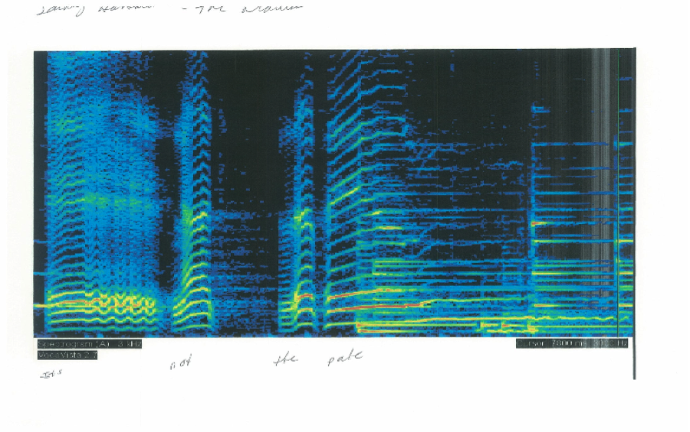
In the following example, Nancy Wilson exhibits a bright tone displayed by the amount of yellow and red in the upper section of the spectrogram. Also, notice a more chopped sense of phrasing indicated by the blocks of black space. Wilson uses jazz stylizations such as upward smears at the beginning of the initial phrase, dips in the middle of the phrase and vibrato at the end of the phrase.
Figure 2: Nancy Wilson (2005) ‘The Nearness of You’, Great American Songbook (Blue Note Records)
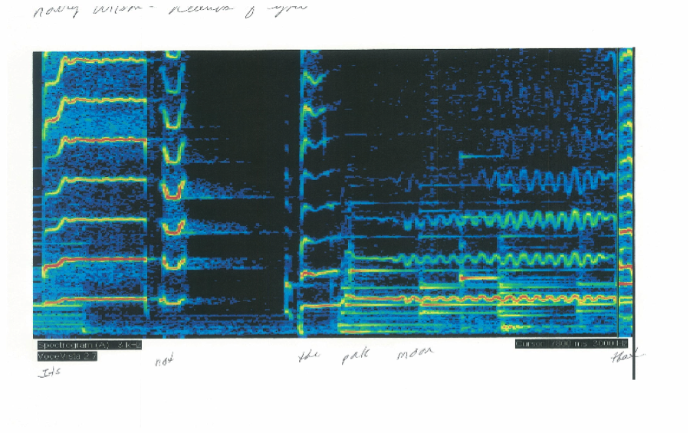
Ella Fitzgerald’s spectrogram indicates a lighter vocal tone indicated by less overall colour. This example shows a very connected sense of phrasing indicated by the evenness of colour in the lower portion of the spectrogram.
Figure 3: Ella Fitzgerald (1997) ‘The Nearness of You’, The best of Ella Fitzgerald and Louis Armstrong (The Verve Music Group)
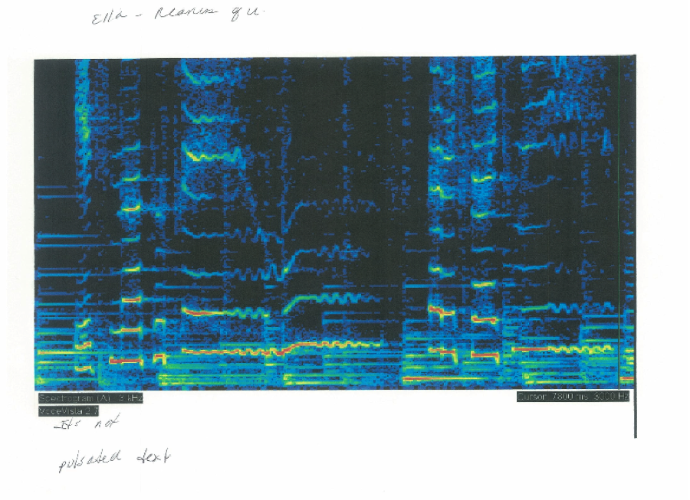
The next spectrogram, based on a recording by Sarah Vaughan, displays the most consistent and present use of tone and vibrato of the singers studied in this paper. Vaughan displays very connected phrasing as indicated by the almost complete absence of black background:
Figure 4: Sarah Vaughan (2004) ‘The Nearness of You’, Love Songs (Columbia/Legacy Records)
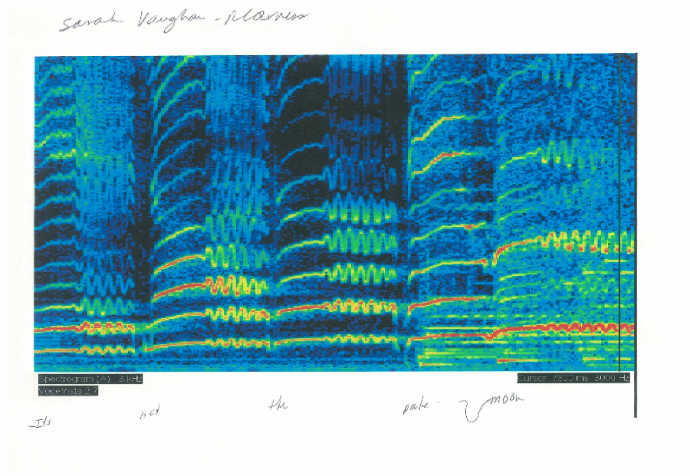
The fifth and final spectrogram displays a representation of Mel Tormé’s light yet consistent tone. Notice also the contour of phrasing and stylistic use of vibrato:
Figure 5: Mel Tormé (1993) ‘The Nearness of You’, 16 Most Requested Songs (Legacy/Columbia Records)
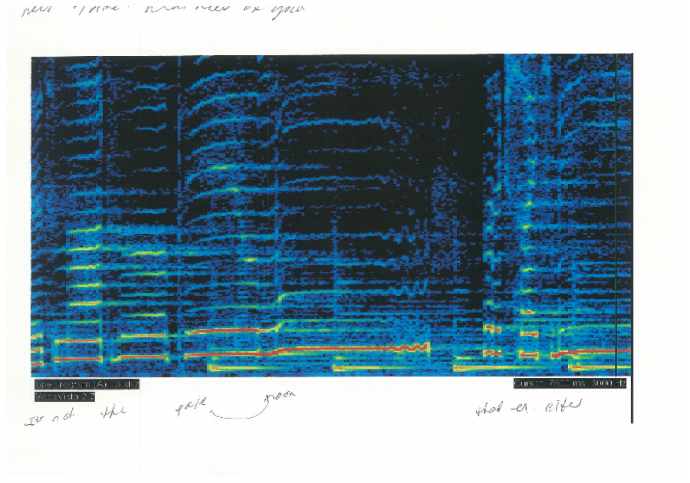
6. Conclusion
The key to informed music listening, of course, is understanding ‘how’ to listen and ‘what’ to listen for by categorizing elements of performance. By identifying elements of jazz that are similar in early music, singers of early music can use vocal jazz recordings to deepen their sense of the subtleties of artistic choice. Recordings can provide much information concerning the appropriateness of musical applications and individual preference, not to mention the benefit to the ear. The jazz aesthetic is fundamentally based on the individualized and experiential interpretation of music. Differences in performances of the same or similar music by various artists are celebrated within the context of specific musical practices that define the overall style. The evidence provided by early sources suggests that the aesthetic of early music, like jazz, may have allowed for individualized interpretation and creativity within the context of common practice.
As with any form of artistry, personal decisions about the scope and placement of a particular musical technique are at the heart of a singer’s expression of individual style. The breadth of one’s musical understanding both in terms of historically informed practice and individual artistic preference enhances a singer’s ability to produce music that has both integrity and creativity. Enriching our understanding of one type of music with an understanding of musical elements and singing techniques from another stylistic tradition that transcends time periods and genres can only enhance personal expression and artistry.
Bibliography
- Appelman, D. R. (1967). The Science of Vocal Pedagogy, Theory and Application. Blooomington, IN: Indiana University Press.
- Bovicelli, G.
B. (1992). ‘Passaggi di Musica of 1594’. Translated by Jesse Rosenbery. Historic Brass Society Journal, Vol. 4, 27–44.
- Brown, H. M. (1976). Embellishing Sixteenth-Century Music. London: Oxford University Press.
- Bunch, M.
(1997). Dynamics of the Singing Voice,
3rd. edn. New York: Springer-Verlag.
- Cooper, T. G. (1986). ‘Two neglected aspects of Renaissance motet performance practice’. Choral Journal, Vol. 27, no. 4, 9–12.
- Donington, R.
(1974). The Interpretation of Early Music.
St. Martins Press: New York.
- Erig, R. (1979). Italian Diminutions. Amadeus Verlad: Zurich/Schweiz.
- Greenlee, R.
(1987). ‘Dispositione di voce: passage to florid singing’. Early Music, Vol. 15, No. 1, 47–55.
- Hall, D. E. (2002). Musical Acoustics, 3rd. edn. California: Wadsworth Group.
- Kendrick, R. L.
(2002). The Sounds of Milan, 1585–1650.
Oxford University Press, Inc.: New York.
- McGee, T. J. and Rigg, A. G. (1996). Singing Early Music: the Pronunciation of European Languages in the Late Middle Ages and Renaissance. Bloomington: Indiana University Press.
- MacClintock, C.
(1979). Readings in the History of Music
in Performance. Indiana University Press, Bloomigton/Indianapolis.
- Miller, R. (1996). The Structure of Singing, System and Art in Vocal Technique. California: Wadsworth Group.
- Mozart, Leopold (1985). A Treatise on the Fundamentals of Violin Playing. Trans. Edith Knocker. Oxford: Oxford University Press.
- Newton, G. and Mowbray-Silver, M (1976). ‘Singing Early Music’. Early Music, Vol. 4, No. 2, 229–31.
- Page, c. (1992). ‘Going beyond the Limits: Experiments with Vocalization in the French Chanson. 1340–1440’. Early Music, Vol. 20, No. 3, 447–59.
- Polk, K. (1990). ‘Voices and Instruments: Soloists and Ensembles in the 15th Century’. Early Music, Vol. 18, No. 2, 179–98.
- Rooley A. (1993). ‘L’humore Universale'. The Musical Times, Vol. 134, No. 1807, 490–495.
- Spradling, D. (2007). Jazz Singing: Developing artistry and authenticity. Sound Music Publications: Edmonds, Washington.
- Strempel, E. L. (2006), ‘The Shifting Aesthetics of Vibrato’. Journal of Singing, Vol. 62, No. 4, 405–11.
- Uberti, M., (1981). ‘Vocal Techniques in Italy in the Second Half of the 16th Century’. Early Music, Vol. 9, No. 4, 186–95.
- Vennard, W. (1967). Singing, the Mechanism and the Technique. New York: Carl Fischer.
- Von Ramm, A (1976). ‘Singing Early Music’. Early Music, Vol. 4, No. 1, 12–15.
- Fitzgerald, Ella (1997). The Nearness of You. The best of Ella Fitzgerald and Louis Armstrong, The Verve Music Group.
- Hartmann, Johnny (1972). The Nearness of You. For Trane, Blue Note Records.
- Murphy, Mark (1997). Fascinating Rhythm. The Best of Mark Murphy: The Capitol Years, Blue Note Records.
- Reeves, Diane (2001). Fascinating Rhythm. The Calling, Blue Note Records.
- Torme, Mel (1993). The Nearness of You. 16 Most Requested Songs, Legacy/Columbia Records.
- Vaughan, Sarah (2004). The Nearness of You. Love Songs, Columbia/Legacy Records.
- Wilson, Nancy (2005). The Nearness of You. Great American Songbook, Blue Note Records.
Software Program
Miller, D. G., Schutte, H. K., and Nair, Garyth. Voce Vista.
Leila Heil
Leila Heil is Assistant Professor of Music Education at The Ohio State University. She brings with her twenty-one years of public school teaching experience at the secondary level. She most recently served as choral director and Fine Arts Department Coordinator at Cherry Creek High School in Englewood, Colorado. Dr Heil holds a BM from Colorado State University, a MM in choral conducting from Arizona State University and a PhD in Music Education from the University of Colorado, Boulder. Dr Heil has been active in state music organizations for many years having served on the Arizona Music Educators executive board, as festival chair for the Arizona All-State Jazz and Show choirs, and representative to the Arizona Interscholastic Association. She recently served as Repertoire and Standards chair for the Colorado ACDA. Dr Heil is the assistant director for the National High School Grammy Jazz Choir.
- Howard Mayer Brown, Embellishing Sixteenth-Century Music (Oxford University Press, 1976), 25.
- Brown, ibid.
- Mauro Uberti, ‘Vocal Techniques in Italy in the Second Half of the 16th Century’ Early Music, 9:4 (1981), 486–98, at 489.
- Uberti, ibid.
- George Newton & Michael Mowbray-Silver. ‘Singing Early Music’ Early Music, 4:2 (1976), 229.
- Ibid, 231.
- Carol MacClintock, Readings in the History of Music in Performance (Indiana University Press, 1979), 41.
- Strempel, ‘The Shifting Aesthetics of Vibrato’, Journal of Singing 62/4, 406.
- Uberti, 'Vocal Techniques', 493.
- Brown, Embellishing Sixteenth-Century Music, p. xxi.
- Ibid.
- See Brown, Embellishing Sixteenth-Century Music.
- Brown ibid., 48.
- Ibid., 25.
- Ibid., 25.
- T. J. McGee, T. J. and A. G. Rigg, Singing Early Music: the Pronunciation of European Languages in the Late Middle Ages and Renaissance (Bloomington: Indiana University Press, 1996), preface.
- A. Rooley A. (1993) ‘L’humore Universale’, The Musical Times, Vol. 134, No. 1807, (1993), 492
- D. Spradling, Jazz Singing: Developing artistry and authenticity (Sound Music Publications: Edmonds, Washington, 2007), 23–35